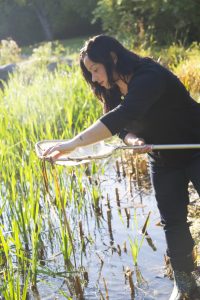Citizen Science Project Examines Mercury Contamination in Dragonfly Larvae
 Last year, citizen scientists across the nation collected dragonfly larvae, which were tested for mercury levels. The final results could indicate risks for other species, including humans and the fish we eat
Last year, citizen scientists across the nation collected dragonfly larvae, which were tested for mercury levels. The final results could indicate risks for other species, including humans and the fish we eat
Sarah Nelson, an associate research professor at UMaine’s Senator George J. Mitchell Center for Sustainability Solutions and the School of Forest Resources, was one of the researchers heading up the project and an author of a new article describing the research protocol in the journal Park Science.
Nelson’s co-authors and co-researchers are Colleen Flanagan Pritz, an ecologist with the National Park Service’s Air Resources Division in Dever, Colorado, and Collin Eagles-Smith, a supervisory research ecologist with the U.S. Geological Survey in Corvallis, Oregon.
Close to 300 volunteers collected 800 larvae samples at far-flung sites, including Maine’s Acadia National Park, Alaska’s Denali National Park and Preserve, Florida’s Big Cypress National Preserve and 39 other sites. High school students from the Youth Conservation Corps were among the participants.
Dragonfly larvae present an ideal vehicle for researchers and park managers to help citizen scientists connect with the natural world, researchers report in the article. Though fish are a commonly used indicator for mercury contamination because they provide strong links to human and wildlife health, dragonfly larvae are easier to collect, and represent the risk from mercury in other ecosystems like shallow ponds, ephemeral pools, and marshes – all ecologically important aquatic habitats. As surrogates for ecosystem health, they can be used to detect the potential risk to humans, researchers report.
Final results will be published later in a peer-reviewed journal and will be incorporated into larger-scale mercury research synthesis efforts. More information can be found at the project’s website.
See more about Sarah Nelson’s mercury research here.
